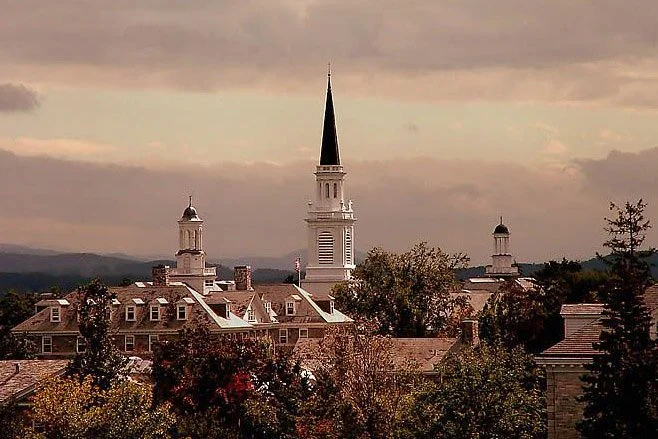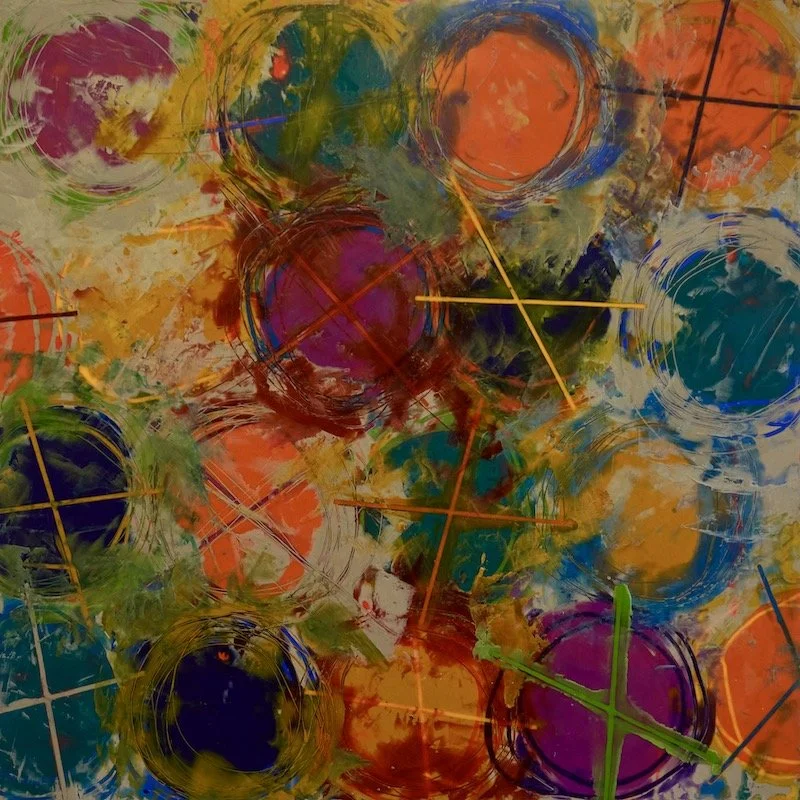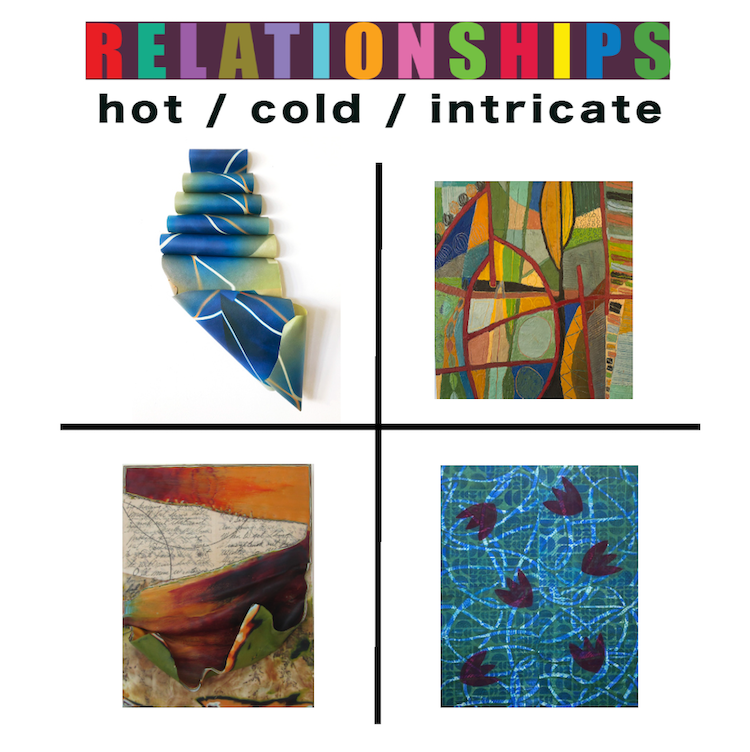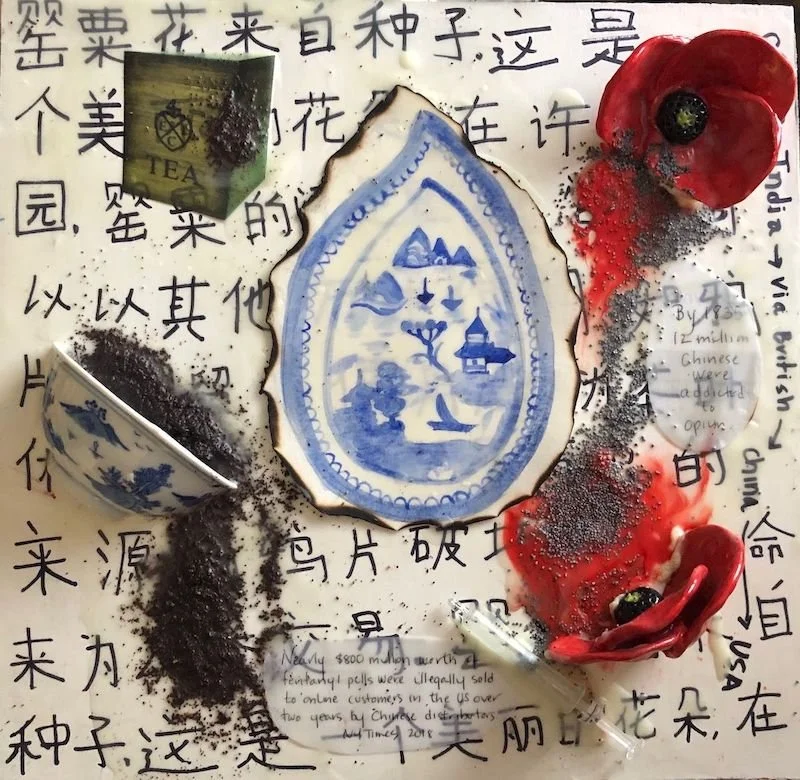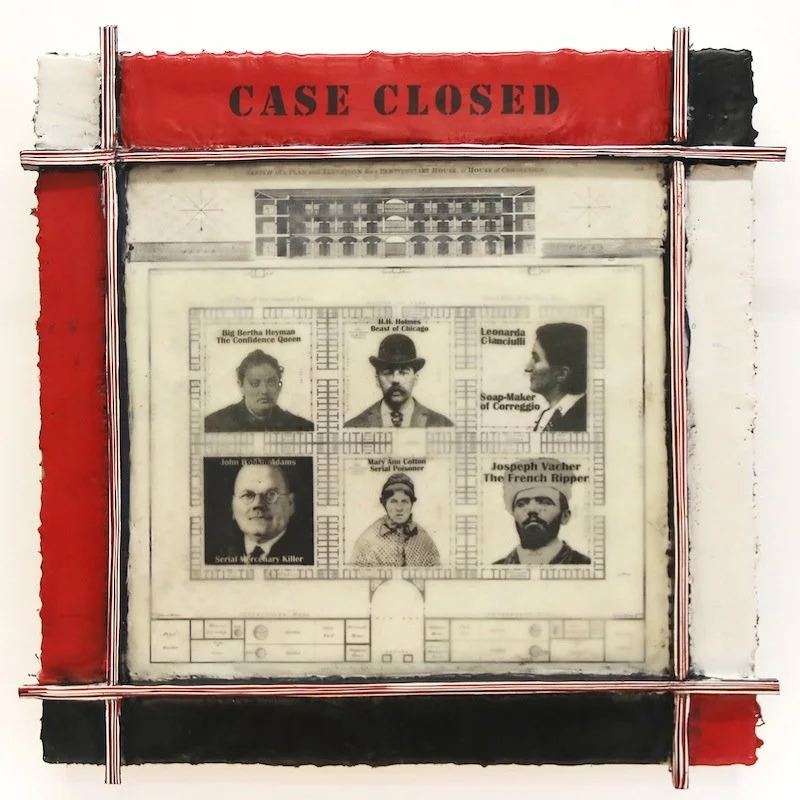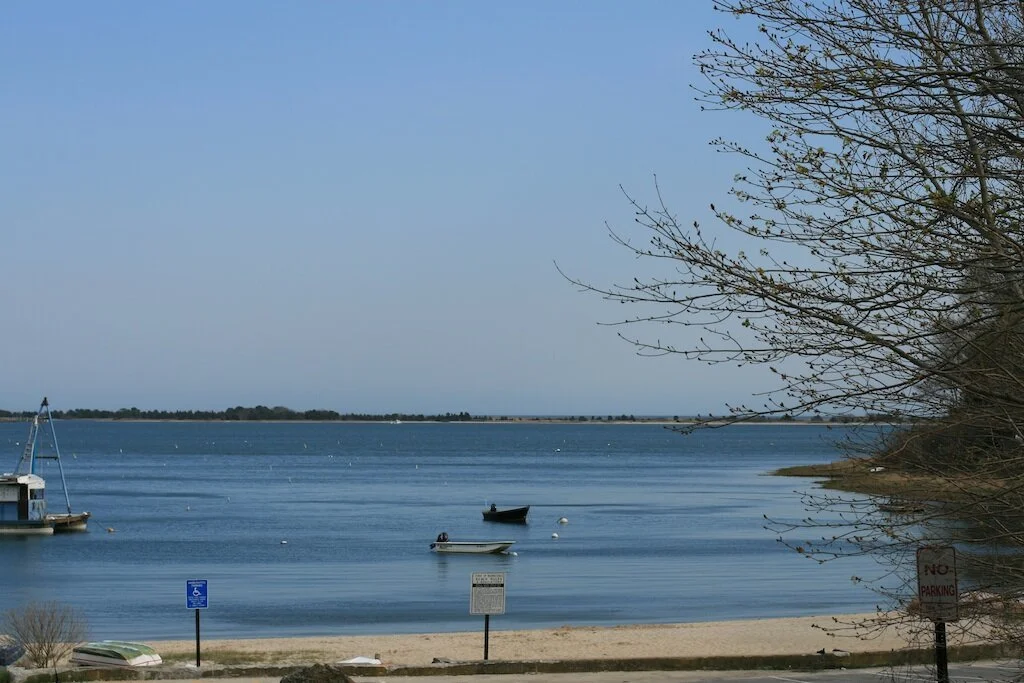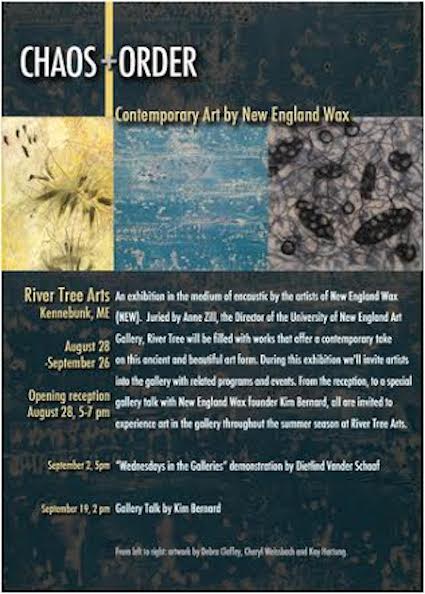
‘Byproduct’ of daily life
“The Age of Aquarium” (encaustic with layered toner transfers), by Providence-based artist Angel Dean, in New England Wax’s group show “Transparency,’’ at Wellfleet (Mass.) Preservation Hall, May 21-June 27. Also see the 17th Annual International Encaustic Conference in nearby Provincetown, May 31-June 2.
Ms. Dean’s artist statement includes this:
“Angel Dean is an artist who mainly works with encaustic media. Her work is personal and unconventional. By contesting the division between the realm of memory and the realm of experience, Dean makes work that is the by-product of the life she’s living.
“‘The advice I like to give young artists, or really anybody who’ll listen to me, is not to wait around for inspiration. Inspiration is for amateurs; the rest of us just show up & get to work. If you wait around for the clouds to part & a bolt of lightning to strike you in the brain, you are not going to make an awful lot of work. All the best ideas come out of the process; they come out of the work itself. Things occur to you.”’
— Chuck Close
Perspectives on transparency
“Transparency’’ — a show by members of New England Wax
May 21 – June 27, 2024
Wellfleet Preservation Hall
335 Main Street in Wellfleet, MA
Reception: Saturday, June 1, 5–7pm
Open to the public Tuesday – Friday 10am–4pm, and during events.
Transparency, featuring works from 27 artists, seeks to investigate the concept of transparency in all its forms. Wax is a mutable material, capable of changing its form and adapting to its environment. Utilizing light, texture, form, and color, works in this exhibition play with the literal qualities of transparency, with pieces that are both ethereal or illusory and grounded in the physical world. Others explore the metaphorical dimensions of transparency, examining issues of trust, accountability, and communication. Through the works of a range of artists working with wax, the exhibition invites viewers to reflect on the significance of transparency in our society and explore its relationship to power, communication, and the human experience. Each piece in the exhibition offers a unique perspective on transparency and its many layers of meaning, creating a cohesive and thought-provoking narrative.
Wellfleet Preservation Hall is a vibrant cultural center that uses the transformational power of the arts to bring people together and impact positive change. It is a community center that celebrates people from all backgrounds and walks of life.
335 Main Street, Wellfleet, MA • 508-349-1800
Exhibiting Artists:
Katrina Abbott
Lola Baltzell
Edith Beatty
Hilary Hanson Bruel
Lisa Cohen
Angel Dean
Pamela Dorris DeJong
Heather Leigh Douglas
Hélène Farrar
Dona Mara Friedman
Kay Hartung
Anne Hebebrand
Sue Katz
Janet Lesniak
Ross Ozer
Deborah Peeples
Deborah Pressman
Stephanie Roberts-Camello
Lia Rothstein
Melissa Rubin
Ruth Sack
Sarah Springer
Donna Hamil Talman
Marina Thompson
Lelia Stokes Weinstein
Charyl Weissbach
Nancy Whitcomb
Ready to pounce
“Shadow Cat” ( pan pastel, encaustic, toner transfer, pen & ink on cradled panel), by Heather Leigh Douglas, a member of New England Wax who’s based in Middlebury, Vt., and Upstate New York.
She says:
“I find it very important to have an emotional connection to that which I am painting. For me that occurs from actually being present and seeing the subject with my own eyes. This allows me to paint the images from my own perspective. In addition the emotions that are generated from my time spent in a certain place, as well as the emotions and memories that occur during the painting process, all become a part of the final piece. In this way each painting is unique and one of a kind.’’
Middlebury College
‘Insecurity and surprise’
“Resonance” (encaustic painting), by Deborah Peeples, who has a studio in Somerville, Mass., and lives in neighboring Cambridge.
She writes in the New England Wax Web site:
“Painting is my sensual response to the world, a time-release recording of the sounds, smells, and intensity of a moment. Abstraction is a language that traces my inner turbulence and exuberance. The natural translucent materials of beeswax and damar contain a lush baroque beauty. Mixing pigments, playing with opacity, heating the panel, always touching, breathing the smell of the hot beeswax, brings a slowness and intimacy to the process. The work is layered, incised, inlaid, and scraped; lines cut into the surface, either sharp or blurred, feel alternately vulnerable and impenetrable. Humor and playfulness are found in the saturated, syncopated color and jostling shapes that play off an underlying grid. These juxtapositions create imbalance, insecurity, and surprise, a metaphor for the search to find my place in the world’’.
Harvard Square, in Cambridge
— Photo by chensiyuan
Big show at Vermont art museum features exciting ancient medium; see video
See this very unusual and exciting show at the Southern Vermont Art Center's Wilson Museum, Manchester, Vt., through Aug. 14: Hit this link for a video about the show.
It's titled "RELATIONSHIPS: hot, cold, intricate'' and features New England Wax, a regional association of 31 artists who work in encaustic and other wax mediums. The museum notes that encaustic, in Greek, means “to burn in”.
"It is an exciting art medium with a rich history that offers many creative options. Composed of beeswax, tree resin, and pigment applied with a brush or other tools while molten, each layer is fused to the previous one using a heat gun, torch, or other heated implement. Cold wax is a more contemporary medium combined with oil paint or other pigmenting methods. Each of these wax mediums offers many possibilities for translucency, layering, incising, and other techniques in both 2D and 3D work. The exhibiting artists, from the six New England states, use creative interpretations of the RELATIONSHIPS theme to demonstrate the many expressive and unique possibilities of working with wax-based materials.''
Beauty from New England’s drugged-up China Trade
“China Trade: Opium through the Ages” (encaustic, ceramic made and found objects, tea leaves, poppy seeds on panel), by Cambridge,Mass.-based artist Katrina Abbott.
New England’s “China Trade,’’ in the late 18th Century and the first half of the 19th, created great wealth for some in the region, mostly in and around its ports. Some of the trade involved selling opium to the Chinese. Much of that wealth was invested in what became very lucrative industries, such as textile, shoe and machinery manufacturing and railroads.
In her Web site, Ms. Abbott describes herself thusly:
“Katrina Abbott came to art later in life after her twins were born. Previous to this, she spent 25 years in education, including outdoor education, ocean education at sea and urban public school reform. With a BA in Environmental Biology and a Masters in Botany (studying seaweed!), she reflects her interest in and concern for the natural world in her art. She represents the nature in print, paint, wax ( encaustic) and mosaic. She is a member of the Cambridge Art Association and New England Wax and lives in Cambridge with her husband, their 20 year old boy/girl twins and small brown rabbit named Jarvis.’’
Derby House, in Salem, Mass. Elias Hasket Derby was among the wealthiest and most celebrated of post-Revolutionary War merchants in Salem. He was owner of the Grand Turk, said to be the first New England vessel to be used to trade directly with China. There were many mansions built by merchants in the China Trade, some of which was a drug trade.
—Photo by Daderot
Creative criminals of yore
“Case Closed” (encaustic with image transfers), by Providence-based artist Angel Dean. She is a member of New England Wax (newenglandwax.com)
Snarls at sunset
“Dog Park at Dusk” (watercolor on cradled board, encaustic), by Nancy Whitcomb, a Providence-based artist and member of New England Wax (newenglandwax.com)
Peddle faster
“Resistance” (encaustic on panel), by Hélène Farrar, of Manchester, Maine, from her “What We Carry’’ series. Her work will be shown in New England Wax’s (newenglandwax.com) show “Layering: The Art and Experience of Hot Wax,’’ at the Cotuit (Mass.) Center for the Arts June 26-Aug. 7.
Rope's Beach, in Cotuit, looking onto Cotuit Bay. Cotuit has drawn many artists to work and show there , mostly in the summer, since the late 19th Century.
Part of this long popular summer-cottage lake is in Manchester, where Ms. Farrer lives and works.
Coast painting
“Metal Scape Navy 1’ (encaustic painting), by Charyl Weissbach, in the show at The New Bedford Art Museum, Jan. 21-March 14. Her studio is in Boston’s SoWa arts district.
(Timed-Ticket Reception: 3/13/2021, 12-2 PM)
Featuring: Willa Vennema, Stephanie Roberts-Camello, Pamela Dorris DeJong, Lola Baltzell, Nancy Whitcomb, Lia Rothstein, Deborah Peeples, Kay Hartung, Marina Thompson, Angel Dean, Lelia Stokes Weinstein, Ruth Sack, Sarah Springer, Charyl Weissbach and Camille Davidson
“Fluid States: New England Wax/New England Waters’’ highlights encaustic artworks inspired by New England’s historic and awe-inspiring coasts. Themed around the fluidity seen in both wax and water, “Fluid States’’ explores New England’s ecological richness and fragility. Protecting our water and the life that depends on it is an urgent necessity. In this exhibition, the artists address this urgency as they work to express water’s sheer beauty through innovative approaches to an ancient medium.
Our water wonders
At The New Bedford Art Museum, Jan. 21-March 14
(Timed-Ticket Reception: 3/13/2021, 12 – 2 PM)
Featuring: Willa Vennema, Stephanie Roberts-Camello, Pamela Dorris DeJong, Lola Baltzell, Nancy Whitcomb, Lia Rothstein, Deborah Peeples, Kay Hartung, Marina Thompson, Angel Dean, Lelia Stokes Weinstein, Ruth Sack, Sarah Springer, Charyl Weissbach and Camille Davidson
“Fluid States: New England Wax/New England Waters’’ highlights encaustic artworks inspired by New England’s historic and awe-inspiring coasts. Themed around the fluidity seen in both wax and water, Fluid States explores New England’s ecological richness and fragility. Protecting our water and the life that depends on it is an urgent necessity. In this exhibition, the artists address this urgency as they work to express water’s sheer beauty through innovative approaches to an ancient medium.
New England Wax (N.E.W.), founded in 2006 by Kim Bernard, is a professional organization of artists living and working in the six New England states. Since its inception, N.E.W. has sought to provide opportunities to exhibit, share technical information and aesthetic ideas, and build a network of like-minded artists working in the ancient medium of encaustic. The mission of N.E.W. is to promote excellence in fine art made with encaustic, educate the general public and collectors, raise awareness of the medium, and challenge its members to grow as artists.
'Three aspects of time'
“Under the Juniper Tree’’ (encaustic) by Boston-based painter Lola Baltzell, in the “Brilliance and Celebration” show at Galatea Fine Art, Boston, through Oct. 31. She is a member of New England Wax (newenglandwax.com).
She says:
"This piece represents the past, the present and the future. Three panels, three aspects of time. Mostly I try to stay in the present. I feel like a refugee who has fled the homeland. I now live in a world that feels so foreign. The past — does it exist? It feels like ‘the old world’: The future? I'm trying to hold a sense of possibility."
The gallery says: “Lola Baltzell's works are uninhibited, yet carefully structured. It is not imposed, but appears as a reflection of natural order. Microbes, cells, direction of energy all serve to inform the surface of her works.’’
See:
galateafineart.com
The story beneath
Work by Stephanie Roberts-Camello (encaustic relief over book pages and casein)
She writes:
“Layers of wax literally cover up the past. Revealed, exhumed, manipulated, up-ended, exposed, all of these actions give me a sense of freedom, and the ability to step outside myself. Seemingly destructive to the surface, the peeling plays a positive roll in removing a build up and seeing what has been lying dormant. The depth created working this way is jarring to me, confrontational, alluring and frightening. There is risk involved, but the presence of this relief work conveys a sense of resilience and life which keeps me returning. It speaks with a boldness and beauty which is also fragile. This opposition between image/content and material is the catalyst for the development of my encaustic relief series. This work continues to evolve as I find new ways to shed light on subjects I want to confront.’’
Quaker meeting house in Pembroke. Southeastern Massachusetts was an early center for Quakers in America.
The artist, a member of New England Wax (newenglandwax.com) lives in Pembroke, Mass., where she and her husband have a business called Queen Bee Honey.
The geography of the once rural, agricultural and fishing town Pembroke, now a Boston suburb, is dominated in the northern part by streams flowing through woods that once provided the lumber for the North River's shipbuilding industry. These streams are famous for their fish runs, including of herring, blue fish and striped bass.
The southern half is dominated by several ponds and Silver Lake, where the towns of Pembroke, Kingston, Plympton and Halifax meet.
Early industries also included smelting bog iron and cutting and selling ice from the town’s many bodies of fresh water.
From Marshfield, looking across the North River toward Pembroke. It’s a fine fishing area.
Finally, some loyalty!
“Waiting for My Master” (encaustic, toner transfer), by Heather Douglas, who has a home in tiny Cornwall, Vt., in the Champlain Valley. She’s a member of New England Wax.
The Champlain Valley
Classic New England: The Cornwall Congregational Church
The North Woods in wax
“Tree Variation #6 ‘‘ (encaustic on panel), by Helene Farrar. She is a member of New England Wax, which promotes the art of encaustic painting, which uses bee’s wax.
From her bio:
“Hélène Farrar has taught and worked in the visual arts for twenty years while actively exhibiting in commercial, nonprofit and university galleries in New England, New York City, Pennsylvania, Italy, and England. Farrar has a BA in Studio Art from the University of Maine and a Masters of Fine Art Degree in Interdisciplinary Arts from Goddard College in Vermont.
“Hélène currently owns and operates her own private art school in Maine out of her ‘Farmhouse’ studio, where she holds varied workshops and classes. Her paintings have most recently been accepted into curated exhibits at the Fuller Craft Museum, the Saco Museum, the University of New England Art Gallery, and Twiggs Gallery in New Hampshire.
“Farrar is represented by Archipelago Fine Arts in Rockland, and the Center for Maine Craft in West Gardiner. Her work as an educator has brought her across the state of Maine including the Haystack Mountain School of Craft. She taught at the 2019 International Encaustics Conference.’’
Layers of history from the '30s
"Eclipse'' (encaustic relief construction over wood and old letters), by Stephanie Roberts-Camello, in her show "Encaustic Shrouds, Free Forms and Missing Pieces series,'' at the Cotuit Center for the Arts, Cotuit, Mass., through April 21.
She explains that her work is primarily of encaustic paint {which uses bee's wax} with which "many layers are built up and fused to each other over text or old family letters from the '30's and '40's during the Depression and the Dust Bowl days of Texas. These letters represent a very difficult time in our country's history -- a time that had to be endured. This work is about confronting and overcoming personal obstacles.'' The aim is "to look at the past in a new light and be free of anything holding one back.''
Ms. Roberts-Camello is a member of the New England Wax consortium.
More than normal
"Normalcy of Beauty'' (encaustic painting (which uses beeswax), by Kimberly Curry, in the"Shifts Exhibition,'' of New England Wax members at the Fuller Museum, Brockton, Mass., through Nov. 26.
The wonders of wax
"Festival of Flags I'' (encaustic), by Jeanne Griffin, in the big group show "Beneath the Surface,'' at the Saco Museum, Saco, Maine, April 2-May 28.
The show includes the work of some of New England's best painters working in encaustic, also known as hot-wax painting. The process involves using a mix of heated beeswax and damar varnish to which colored pigments are added. The liquid or paste is then applied to a surface -- often prepared wood, although canvas and other materials are often used. The effects can be very beautiful --- and sometimes eerie.



